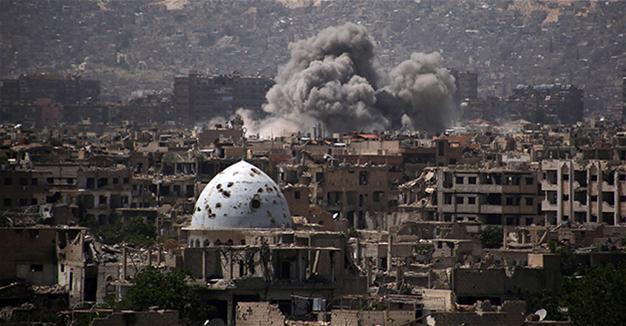Sectarianization: The new politics of the Middle East
William Armstrong - william.armstrong@hdn.com.tr

Smoke rises from buildings after an April 29 air strike on Jobar, a rebel-held district on the eastern outskirts of the Syrian capital Damascus. AFP photo
‘Sectarianization: Mapping the New Politics of the Middle East’ edited by Nader Hashemi and Danny Postel (Hurst, 384 pages, £20)In his last State of the Union speech in 2016, Barack Obama invoked history to explain the current meltdown in the Middle East. The region “is going through a transformation that will play out for a generation, rooted in conflicts that date back millennia,” Obama said. This idea of “ancient sectarian animosity” certainly has a tenacious hold on the public. Sunnis and Shiites, it is said, have been locked in a hate-filled conflict since the Battle of Karbala in the 7th century.
 Sensible commentators have long pushed back against this simplistic thesis. “Sectarianization: Mapping the New Politics of the Middle East” is a new collection of articles penned by top-drawer scholars, showing that the rise of sectarianism is a modern phenomenon with fiendishly complex roots. The book takes in a diverse range of countries – from Bahrain to Pakistan - and is largely intended for academics and professionals working in politics and development. But it is a broadly accessible and stimulating volume. Like much of the pushback, its effect on popular conversation is likely to be limited; that does not mean its core idea is wrong.
Sensible commentators have long pushed back against this simplistic thesis. “Sectarianization: Mapping the New Politics of the Middle East” is a new collection of articles penned by top-drawer scholars, showing that the rise of sectarianism is a modern phenomenon with fiendishly complex roots. The book takes in a diverse range of countries – from Bahrain to Pakistan - and is largely intended for academics and professionals working in politics and development. But it is a broadly accessible and stimulating volume. Like much of the pushback, its effect on popular conversation is likely to be limited; that does not mean its core idea is wrong. Of course, the Islamic world has not always been a wasteland torn apart by violence committed in the name of sectarian identity. Sunni-Shia relations were not always conflict-ridden, nor was sectarianism a strong political force in modern Muslim politics until recently. Syrians and Iraqis with different sectarian identities coexisted for centuries without mass bloodshed. So why has vicious, deadly sectarianism emerged now? The answer resists all sweeping theories. Behind the current turmoil lies a toxic brew of authoritarianism, kleptocracy, developmental stagnation, state repression, geopolitical rivalry and class dynamics. This cocktail has created conditions in which sectarianism can thrive.
Many of the contributors make the key point that lethal sectarianism and politicized identities are often manipulated by authoritarian regimes in pursuit of political gain: The manipulation of passions and the “cultivation of hatred” in the phrase of the late historian Peter Gay. Autocrats use sectarianism to divide the opposition and deflect attention toward foreign enemies who are themselves allegedly “stoking sectarian conflict.” As editors Nader Hashemi and Danny Postel write in the introduction: “There is a symbiotic relationship between social pressure from below – demands for greater inclusion, rights, recognition, and representation – and the refusal by the state from above to share or relinquish power. This produces a crisis of legitimacy that ruling elites must carefully manage to retain power. The result of this political dynamic is sectarianization.”
Related to this political struggle is the way sectarianism has been fueled by the geopolitical rivalry between Saudi Arabia and Iran since the 1970s. To adapt Clausewitz’s aphorism of war as a “continuation of politics by other means,” sectarian conflict in the Middle East today is the perpetuation of political rule via deadly identity mobilization. Sectarianism has become a useful instrument of Realpolitik. Both Tehran and Riyadh lay claim to leadership of the “Islamic world,” and since 1979 they have battled for hearts and minds.
The consequences are grimly evident in today’s Syria, described by George Washington University professor Marc Lynch as “the greatest incubator of sectarianism in the region.” The overthrow of Saddam Hussein in Iraq in 2003 also boosted sectarianism. In an insightful piece, Bassel F. Salloukh describes how Saddam’s removal fueled sectarian authoritarianism, as sabotaging post-Saddam Iraq became an objective of Iran, Syria, and Hezbollah, as well as their rivals Saudi Arabia and Jordan. The country’s neighbors “feared that a stable and democratic Iraq would allow Washington to pursue its post-9/11 ‘Freedom Agenda’ aggressively. Consequently, they resisted U.S. attempts to stabilize and democratize Iraq, opening their borders to Salafi-jihadi fighters en route to Iraq,” writes Salloukh. The geopolitical battle over Iraq, coupled with the post-2006 sectarianization of Iraqi politics, had a ripple effect across the entire region.
The point about state manipulation is certainly important. But parts of “Sectarianization” sometimes appear to suggest that rising sectarianism is purely a result of state strategy. This deemphasizes local agency too much. While authoritarians have certainly manipulated religious feeling to delegitimize grassroots challenges to their rule, it should be noted that those feelings were already latent and open for manipulation in the right circumstances. Similarly, it is also important not to overlook the fact that some uprisings themselves included overdeveloped sectarian sentiments fairly quickly.
Still, there is plenty to learn from each of the book’s chapters. Over 384 pages some of the points become repetitive, but “Sectarianization” is largely free of obfuscating academic lingo. All contributors eschew simplistic conclusions and none of them proffer comforting illusions about the future. “Putting the sectarian genie back in the bottle is unlikely to be easy,” write Hashemi and Postel. They also recognize that unmasking the artificiality of the “ancient hatreds” thesis will do little to counter it. But “Sectarianization” is a useful primer on the dynamics behind the Gordian Knot of today’s Middle East.
* Follow the Turkey Book Talk podcast via iTunes here, Stitcher here, Podbean here, or Facebook here.










